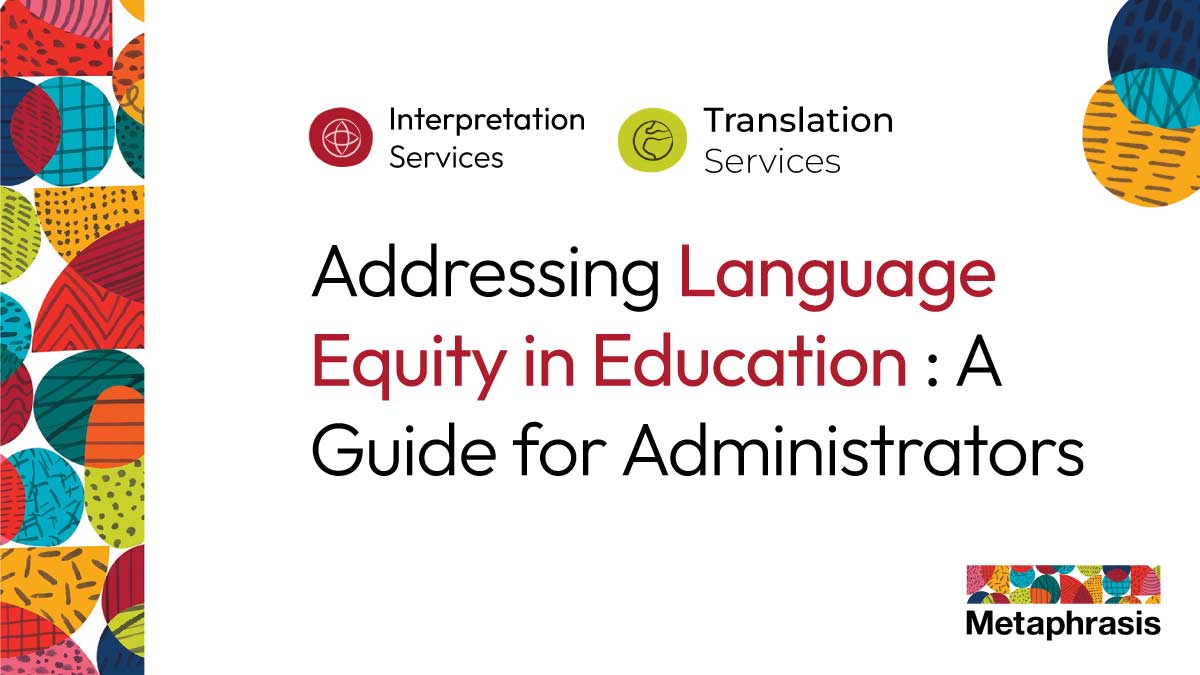
Addressing Language Equity in Education: A Guide for Administrators
In today’s diverse educational landscape, language equity is not just important—it is essential. Schools and districts across the United States are increasingly serving students from multilingual and multicultural backgrounds, making it vital to provide equitable access to education for all learners. Achieving language equity requires more than recognizing linguistic diversity; it involves actionable strategies, robust language services, and a genuine commitment to fostering inclusivity both inside and outside the classroom.
Metaphrasis offers administrators practical advice on implementing language services to support students and families from diverse linguistic backgrounds, addressing language equity in education with insights and best practices that can make a meaningful difference.
Understanding the Language Equity Issue
The number of multilingual learners in U.S. schools continues to grow. According to the National Center for Education Statistics (NCES), approximately 10.4% of public school students were classified as English Language Learners (ELLs) in the 2019–2020 academic year. That’s about 5.1 million students—a number shaped by ongoing immigration trends and demographic shifts.
However, challenges remain:
- Achievement Gaps: ELL students often face performance gaps in reading and math compared to their English-proficient peers (2019 NAEP data).
- Limited Resources: Many districts have difficulty securing enough funding and trained staff to offer strong language support services.
- Parent Engagement Barriers: A 2020 report by the Migration Policy Institute noted that limited English proficiency among parents can restrict their ability to engage with schools, affecting parent-teacher conferences, Individualized Education Programs (IEPs), and access to school notifications.
These findings highlight the importance of comprehensive language services to ensure all students have access to the same educational opportunities.
Why Language Equity Matters
Language equity goes beyond translation and interpretation—it is about creating a learning environment where all students can thrive academically, socially, and emotionally. Schools that prioritize language equity are better equipped to:
- Foster Inclusive Learning Environments: When students see their languages and cultures represented, they feel valued and included, which encourages higher engagement and motivation.
- Promote Academic Success: Linguistic support helps students fully access curriculum content, ensuring they are not left behind due to language differences.
- Strengthen Family-School Partnerships: Clear communication with families builds trust and collaboration, which are essential for student success.
Steps for Implementing Language Services
1. Assess the Needs of Your School Community
Gather data on the linguistic demographics of your student population and their families. Surveys can help identify:
- Primary languages spoken at home
- Translation and interpretation needs
- Barriers families face in accessing school resources
2. Develop a Comprehensive Language Services Plan
A strong plan might include:
- Translation Services: Provide written materials (e.g., handbooks, report cards, notices) in multiple languages.
- Interpretation Services: Offer real-time interpretation for parent-teacher conferences, IEP meetings, and school events.
- Bilingual Staff Training: Prepare teachers and staff to work effectively with multilingual learners and families.
3. Leverage Technology for Accessibility
Technology can simplify and expand access to language services:
- Use apps like TalkingPoints or ClassDojo to send translated messages to parents.
- Implement virtual interpretation platforms for remote meetings.
- Provide students with multilingual digital learning tools.
4. Train and Certify Educators
Teachers play a central role in language equity. Professional development may include:
- Culturally responsive teaching practices
- Scaffolding strategies for language development
- Identifying and addressing unconscious biases
According to the Education Commission of the States, only 20 states currently require ESL-specific training for general education teachers. Expanding this training is an important step toward stronger support for multilingual learners.
5. Engage Families as Partners
Family engagement strengthens student success. Schools can:
- Host multilingual family nights to share resources and build community.
- Provide workshops for parents on navigating the school system.
- Use interpreters during meetings to ensure meaningful participation.
The Role of Language Service Providers
Language service providers are valuable partners for schools and districts. By offering certified interpreters, professional translators, and solutions, these providers help ensure that schools can meet the diverse needs of their communities. Metaphrasis has experience working with public schools and has developed programs such as interpreter training specifically designed for educational settings.

Investing in Language Equity for Long-Term Impact
Addressing language equity is not only about immediate access—it is also an investment in the future. Multilingual students bring rich perspectives to classrooms and will play an important role in a globally connected society. By implementing strong language services, schools can:
- Help close achievement gaps
- Build stronger, more inclusive communities
- Prepare all students for success in an increasingly diverse world
Language equity in education is a shared responsibility. Administrators have the ability to create lasting change by prioritizing language services and fostering inclusivity. By taking practical steps and partnering with trusted providers like Metaphrasis, schools can ensure that every student—no matter their linguistic background—has the opportunity to succeed.
If your school or district is ready to enhance language equity, Contact Metaphrasis Language Services today. Together, we can build learning environments where all voices are heard and valued.
